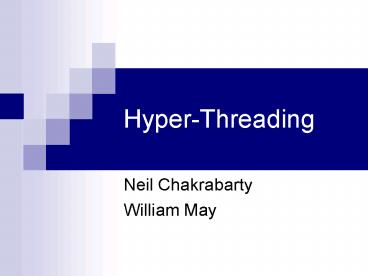Hyper-Threading - PowerPoint PPT Presentation
1 / 17
Title:
Hyper-Threading
Description:
Title: Hyperthreading Author: Neilin Chakrabarty Last modified by: Neilin Chakrabarty Created Date: 4/3/2004 3:49:55 AM Document presentation format – PowerPoint PPT presentation
Number of Views:104
Avg rating:3.0/5.0
Title: Hyper-Threading
1
Hyper-Threading
- Neil Chakrabarty
- William May
2
To Be Tackled
- Review of Threading Algorithms
- Hyper-Threading Concepts
- Hyper-Threading Architecture
- Advantages/Disadvantages
- Applications
3
Threading Algorithms
- Time-slicing
- A processor switches between threads in fixed
time intervals. - High expenses, especially if one of the processes
is in the wait state. - Switch-on-event
- Task switching in case of long pauses
- Waiting for data coming from a relatively slow
source, CPU resources are given to other
processes
4
Threading Algorithms (cont.)
- Multiprocessing
- Distribute the load over many processors
- Adds extra cost
- Simultaneous multi-threading
- Multiple threads execute on a single processor
without switching. - Basis of Intels Hyper-Threading technology.
5
Hyper-Threading Concept
- At each point of time only a part of processor
resources is used for execution of the program
code. - Unused resources can also be loaded, for example,
with parallel execution of another
thread/application. - Extremely useful in desktop and server
applications where many threads are used.
6
(No Transcript)
7
Hyper-Threading Architecture
- First used in Intel Xeon MP processor
- Makes a single physical processor appear as
multiple logical processors. - Each logical processor has a copy of architecture
state. - Logical processors share a single set of physical
execution resources
8
Hyper-Threading Architecture
- Operating systems and user programs can schedule
processes or threads to logical processors as if
they were in a multiprocessing system with
physical processors. - From an architecture perspective we have to worry
about the logical processors using shared
resources. - Caches, execution units, branch predictors,
control logic, and buses.
9
Advantages
- Extra architecture only adds about 5 to the
total die area. - No performance loss if only one thread is active.
Increased performance with multiple threads - Better resource utilization.
10
Disadvantages
- To take advantage of hyper-threading performance,
serial execution can not be used. - Threads are non-deterministic and involve extra
design - Threads have increased overhead
- Shared resource conflicts
11
Applications
- Video Watermark Detection
- Two stages
- Video Decoding
- Image-domain watermark detection
- Video Processing
- 3 stages
- Reading Video information
- Processing Video information
- Writing Video information
12
Video Watermarking
13
Performance Results
14
Video Processing
- Most time is spent in processing.
- Divide the video processing into threads
- 4 Threads in this example
- Have to worry about waiting until all processing
threads are done before writing back the data out.
15
Video Processing (cont.)
16
To Be Tackled
- Review of Threads
- Hyper-Threading Concepts
- Hyper-Threading Architecture
- Advantages/Disadvantages
- Applications
17
References
- Intel Technology Journal. Volume 6 Issue 1.
February 14, 2002 - Intel Hyper-Threading Technology Review
- www.digit-life.com/articles/pentium4xeonhyperthrea
ding/ - HyperThreading Threads Its Way into Application
- http//www.tomshardware.com/cpu/20021227/
- Introduction to Multithreading, Superthreading
and Hyperthreading - http//www.arstechnica.com/paedia/h/hyperthreading
/hyperthreading-1.html































